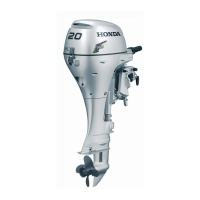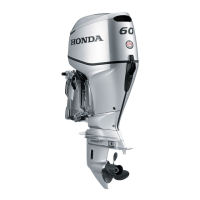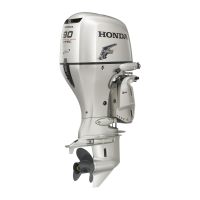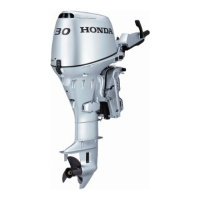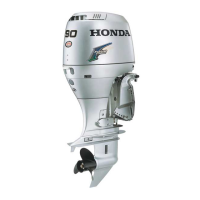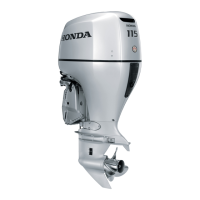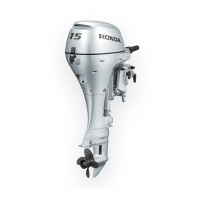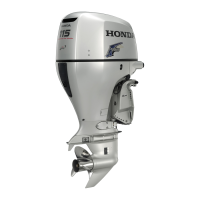Do you have a question about the Honda Marine BF40A and is the answer not in the manual?
Discusses the importance of safety and types of safety information provided.
General safety advice for operating the outboard motor.
Outlines the operator's duties and responsibilities for safe operation.
Provides instructions and precautions for refueling the outboard motor.
Warns about the dangers of carbon monoxide from exhaust.
Shows where safety labels are located on the motor.
Identifies components of the tiller handle type outboard motor.
Identifies components of the remote control type outboard motor.
Explains how to use the engine start button.
Describes the gearshift lever positions (Forward, Neutral, Reverse).
Explains how to use the choke knob for cold starts.
How to adjust engine speed using the throttle grip.
Shows how the indicator relates to throttle opening.
How to set and release throttle grip for steady speed.
How to stop the engine using the stop switch.
How to use the lanyard for emergency stops.
Explains the function of the oil pressure indicator light.
Explains the function of the overheat indicator light.
Controls gear selection and throttle opening.
Prevents accidental gear engagement.
Explains the functions of the ignition switch positions.
How to use the emergency stop switch and lanyard.
Provides electric choke and engine fast idle functions.
Used for starting when the battery is discharged.
Explains the oil pressure warning system.
Explains the overheat warning system.
Adjusts motor trim and tilt angles.
Adjusts motor trim angle for boat trim and performance.
Adjusts motor tilt angle for shallow water, beaching, etc.
Convenience switch for tilting during trailering/maintenance.
Indicates motor trim angle for performance.
Shows approximate engine speed in RPM.
Used for manual tilting if power tilt fails.
Holds the motor in the highest tilt position when moored.
Adjusts for torque steer and functions as an anode.
Convenience switch for tilting during maintenance.
Manual tilting procedure if power tilt fails.
How to use the tilt lock lever when the boat is moored.
Allows tilting the motor to FREE or LOCK positions.
Sacrificial material to protect motor from corrosion.
Monitors cooling water circulation.
Where engine cooling water is drawn in.
Adjusts motor angle for correct boat trim.
Controls air entry/exit for the fuel tank.
Limits maximum engine RPM to prevent damage.
Instructions for removing and installing the engine cover.
Importance of engine oil for performance and service life.
How to check and refill the fuel tank.
Specifies recommended unleaded gasoline types.
Information on using fuels with ethanol or MTBE.
How to check and handle propeller and cotter pin.
Adjusting steering friction for smooth operation.
Adjusting friction for remote control lever.
Includes checks for fuel hose, stern bracket, tool kit, and anodes.
Securing the fuel tank and operating the vent knob.
How to connect the fuel hose to the motor and tank.
Step-by-step guide for starting the tiller handle type.
How to stop the engine using the emergency switch.
How to stop the engine normally.
Aligning start symbol and turning grip for speed.
How to use the choke knob when starting.
How to use the start button.
Verifying water flow after starting.
Checking the oil pressure indicator light.
Step-by-step guide for starting the remote control type.
Engaging the emergency stop switch and lanyard.
Moving the control lever to the neutral position.
Using the lever for cold start and fast idle.
Turning the ignition key to start the engine.
Procedure for starting the engine in an emergency.
Instructions for removing the engine cover for emergency starting.
Instructions for removing the flywheel cover.
Moving the shift or control lever to neutral.
Engaging the emergency stop switch.
Using the manual choke knob.
Aligning symbols and lifting the lever.
How to use the emergency starter rope.
Lists causes and remedies for engine not starting.
Instructions for the initial break-in period of the motor.
Operating instructions specific to the tiller handle type.
How to shift gears using the tiller handle.
How to steer the boat using the tiller handle.
Adjusting trim for cruising conditions.
How to increase speed using the throttle grip.
Setting and releasing the throttle for steady speed.
Operating instructions specific to the remote control type.
How to shift gears using the remote control.
Adjusting trim for cruising conditions with remote control.
Operating instructions specific to gas assisted tilt type.
How to tilt the motor up or down.
How to lock the motor in position for mooing.
Operating instructions specific to power trim/tilt type.
Adjusting motor angle for trim and tilt.
Adjusting motor trim angle for boat performance.
Adjusting motor tilt angle for shallow water, beaching, etc.
Indicates the trim angle of the motor.
Convenience switch for tilting during maintenance.
Manual tilting procedure if power tilt fails.
How to use the tilt lock lever when the boat is moored.
Adjusting the trim tab for torque steer.
Information on motor protection systems and warnings.
Explains warning systems for oil pressure and overheating.
What to do when the overheat warning system is activated.
How the over-rev limiter works and what to do if activated.
How the power trim warning system operates.
Function and maintenance of anodes for corrosion protection.
How to operate the motor in shallow water.
Performance considerations at high altitudes.
How to stop the engine using the emergency switch.
How to stop the engine normally.
How to stop the engine using the emergency switch.
How to stop the engine normally.
Recommendations for trailering the boat with the motor attached.
Procedures for transporting the motor horizontally.
How to clean and flush the motor.
Instructions for using the flush kit coupler.
Why regular maintenance is essential.
General safety precautions for maintenance.
Key safety rules before performing maintenance.
Information on emissions and their sources.
Regulations regarding emission control systems.
What constitutes tampering with emission systems.
Symptoms indicating emission control issues.
Recommendations for using genuine Honda parts.
Following the maintenance schedule for optimal use.
Explanation of the star label for cleaner marine engines.
List of tools and spare parts supplied with the motor.
Schedule for regular maintenance tasks.
Oil check and change intervals, capacity, and recommended oil.
Oil check and change intervals, capacity, and recommended oil.
Spark plug check, adjustment, and replacement intervals.
Minimum requirements and installation for the battery.
Lubrication intervals and points for applying grease.
Fuel filter check and change intervals.
Fuel tank and filter cleaning interval and inspection.
Procedure for cleaning the fuel tank.
Fuel tank filter cleaning and replacement.
How to replace a blown fuse.
How to replace a damaged propeller.
Procedure for servicing a motor that has been submerged.
Procedure for draining carburetors before storage.
Steps for preparing the fuel tank for storage.
Recommended positions for transport and storage.
Lists causes and remedies for engine not starting.
Lists causes and remedies for engine stopping.
Lists tuneup specifications for both models.
Information on obtaining warranty service and contacting customer relations.
Discusses the importance of safety and types of safety information provided.
General safety advice for operating the outboard motor.
Outlines the operator's duties and responsibilities for safe operation.
Provides instructions and precautions for refueling the outboard motor.
Warns about the dangers of carbon monoxide from exhaust.
Shows where safety labels are located on the motor.
Identifies components of the tiller handle type outboard motor.
Identifies components of the remote control type outboard motor.
Explains how to use the engine start button.
Describes the gearshift lever positions (Forward, Neutral, Reverse).
Explains how to use the choke knob for cold starts.
How to adjust engine speed using the throttle grip.
Shows how the indicator relates to throttle opening.
How to set and release throttle grip for steady speed.
How to stop the engine using the stop switch.
How to use the lanyard for emergency stops.
Explains the function of the oil pressure indicator light.
Explains the function of the overheat indicator light.
Controls gear selection and throttle opening.
Prevents accidental gear engagement.
Explains the functions of the ignition switch positions.
How to use the emergency stop switch and lanyard.
Provides electric choke and engine fast idle functions.
Used for starting when the battery is discharged.
Explains the oil pressure warning system.
Explains the overheat warning system.
Adjusts motor trim and tilt angles.
Adjusts motor trim angle for boat trim and performance.
Adjusts motor tilt angle for shallow water, beaching, etc.
Convenience switch for tilting during trailering/maintenance.
Indicates motor trim angle for performance.
Shows approximate engine speed in RPM.
Used for manual tilting if power tilt fails.
Holds the motor in the highest tilt position when moored.
Adjusts for torque steer and functions as an anode.
Convenience switch for tilting during maintenance.
Manual tilting procedure if power tilt fails.
How to use the tilt lock lever when the boat is moored.
Allows tilting the motor to FREE or LOCK positions.
Sacrificial material to protect motor from corrosion.
Monitors cooling water circulation.
Where engine cooling water is drawn in.
Adjusts motor angle for correct boat trim.
Controls air entry/exit for the fuel tank.
Limits maximum engine RPM to prevent damage.
Instructions for removing and installing the engine cover.
Importance of engine oil for performance and service life.
How to check and refill the fuel tank.
Specifies recommended unleaded gasoline types.
Information on using fuels with ethanol or MTBE.
How to check and handle propeller and cotter pin.
Adjusting steering friction for smooth operation.
Adjusting friction for remote control lever.
Includes checks for fuel hose, stern bracket, tool kit, and anodes.
Securing the fuel tank and operating the vent knob.
How to connect the fuel hose to the motor and tank.
Step-by-step guide for starting the tiller handle type.
How to stop the engine using the emergency switch.
How to stop the engine normally.
Aligning start symbol and turning grip for speed.
How to use the choke knob when starting.
How to use the start button.
Verifying water flow after starting.
Checking the oil pressure indicator light.
Step-by-step guide for starting the remote control type.
Engaging the emergency stop switch and lanyard.
Moving the control lever to the neutral position.
Using the lever for cold start and fast idle.
Turning the ignition key to start the engine.
Procedure for starting the engine in an emergency.
Instructions for removing the engine cover for emergency starting.
Instructions for removing the flywheel cover.
Moving the shift or control lever to neutral.
Engaging the emergency stop switch.
Using the manual choke knob.
Aligning symbols and lifting the lever.
How to use the emergency starter rope.
Lists causes and remedies for engine not starting.
Instructions for the initial break-in period of the motor.
Operating instructions specific to the tiller handle type.
How to shift gears using the tiller handle.
How to steer the boat using the tiller handle.
Adjusting trim for cruising conditions.
How to increase speed using the throttle grip.
Setting and releasing the throttle for steady speed.
Operating instructions specific to the remote control type.
How to shift gears using the remote control.
Adjusting trim for cruising conditions with remote control.
Operating instructions specific to gas assisted tilt type.
How to tilt the motor up or down.
How to lock the motor in position for mooing.
Operating instructions specific to power trim/tilt type.
Adjusting motor angle for trim and tilt.
Adjusting motor trim angle for boat performance.
Adjusting motor tilt angle for shallow water, beaching, etc.
Indicates the trim angle of the motor.
Convenience switch for tilting during maintenance.
Manual tilting procedure if power tilt fails.
How to use the tilt lock lever when the boat is moored.
Adjusting the trim tab for torque steer.
Information on motor protection systems and warnings.
Explains warning systems for oil pressure and overheating.
What to do when the overheat warning system is activated.
How the over-rev limiter works and what to do if activated.
How the power trim warning system operates.
Function and maintenance of anodes for corrosion protection.
How to operate the motor in shallow water.
Performance considerations at high altitudes.
How to stop the engine using the emergency switch.
How to stop the engine normally.
How to stop the engine using the emergency switch.
How to stop the engine normally.
Recommendations for trailering the boat with the motor attached.
Procedures for transporting the motor horizontally.
How to clean and flush the motor.
Instructions for using the flush kit coupler.
Why regular maintenance is essential.
General safety precautions for maintenance.
Key safety rules before performing maintenance.
Information on emissions and their sources.
Regulations regarding emission control systems.
What constitutes tampering with emission systems.
Symptoms indicating emission control issues.
Recommendations for using genuine Honda parts.
Following the maintenance schedule for optimal use.
Explanation of the star label for cleaner marine engines.
List of tools and spare parts supplied with the motor.
Schedule for regular maintenance tasks.
Oil check and change intervals, capacity, and recommended oil.
Oil check and change intervals, capacity, and recommended oil.
Spark plug check, adjustment, and replacement intervals.
Minimum requirements and installation for the battery.
Lubrication intervals and points for applying grease.
Fuel filter check and change intervals.
Fuel tank and filter cleaning interval and inspection.
Procedure for cleaning the fuel tank.
Fuel tank filter cleaning and replacement.
How to replace a blown fuse.
How to replace a damaged propeller.
Procedure for servicing a motor that has been submerged.
Procedure for draining carburetors before storage.
Steps for preparing the fuel tank for storage.
Recommended positions for transport and storage.
Lists causes and remedies for engine not starting.
Lists causes and remedies for engine stopping.
Lists tuneup specifications for both models.
Information on obtaining warranty service and contacting customer relations.
| HP Rating | 40 HP |
|---|---|
| Starting System | Electric |
| Lubrication | Wet Sump |
| Steering | Remote |
| Displacement | 808 cc |
| Full Throttle RPM Range | 5, 000-6, 000 RPM |
| Cooling System | Water Cooled |
| Exhaust | Through Propeller |
| Recommended Fuel | Unleaded Gasoline (86 Octane) |
| Alternator | 12 Amp |
| Trim Method | Power trim and tilt |
| Fuel Tank Capacity | Optional |


